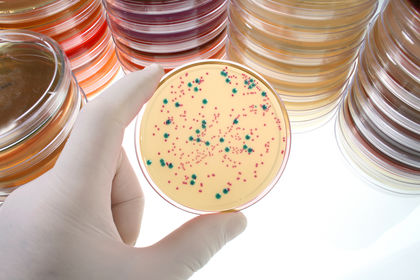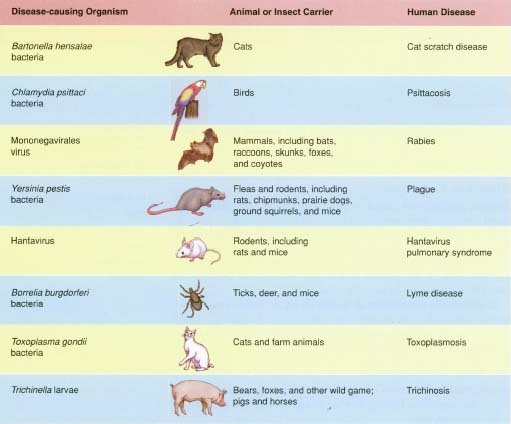Zoonoses

Zoonoses (zoh-ah-NO-seez) are infections that humans contract from animals.
KEYWORDS
for searching the Internet and other reference sources
Cat scratch disease
Hantavirus
Lyme disease
Plague
Psittacosis
Rabies
Toxoplasmosis
Trichinosis
What Are Zoonoses?
Zoonoses are infections caused by parasites, bacteria, or viruses that are passed from animals to humans. Most people contract zoonotic (zoh-uh-NAH-tik) infections from animals with which they have a lot of contact, such as pets or farm animals. Wild animals and insects can be the source of disease, too, particularly for diseases spread by the bite of a tick, mosquito, or fly. Animals such as wild rodents and bats also can carry diseases that may be harmful to humans.
Zoonoses can cause minor or serious illness. In some cases, the organisms involved infect people, but they do not become ill. Other zoonoses can be very dangerous to people, especially anyone with an immune system weakened by age or illness.
Are They Contagious?
Most of these infections do not spread from person to person or do so only in rare instances. Usually they are spread from animals to humans in the following ways:
- from the bite of an infected insect
- through contact with an animal's feces * or urine, either through the mouth or by breathing in dust from dried feces
- from the bite or scratch of an infected animal
- from eating the meat of an infected animal
* feces (FEE-seez) is the excreted waste from the gastrointestinal tract.
* lymph (LIMF) nodes are small, bean-shaped masses of tissue that contain immune system cells that fight harmful microorganisms. Lymph nodes may swell during infections.
Some Examples of Zoonoses
Cat scratch disease
A cat carrying Bartonella henselae (bar-tuh-NEH-luh HEN-suh-lay), the bacterium responsible for cat scratch disease, usually does not have symptoms, but if the bacteria are passed to a human through a scratch or bite, a person may experience skin sores, swollen and sore lymph nodes * , extreme tiredness, headaches, and fever. Antibiotics may be prescribed to treat the infection.

Psittacosis
People who have contact with birds may be at risk for psittacosis (sih-tuh-KO-sis), also known as parrot fever. If a person inhales bird feces or urine particles while cleaning a bird's cage, he or she may develop symptoms of pneumonia (nu-MO-nyah, inflammation of the lung), such as fever, coughing, or chest pain. Antibiotics are used to treat psittacosis.
Rabies
A virus that is carried in the saliva of infected animals can cause rabies when transmitted through a bite or, less commonly, through contact with saliva. Symptoms include fever, difficulty swallowing, delirium * , seizures * , and coma * . Death can result if the infection is not treated. Treatment includes intensive care in a hospital. A series of vaccinations * started at the time of a bite from a possibly infected animal can prevent the person from developing the disease. Many mammals, especially raccoons, bats, and dogs, may be infected with rabies, but human rabies is rare in the United States. According to the U.S. Centers for Disease Control and Prevention, there were no cases of rabies in humans in the United States in 2000. In many other countries, especially those in the developing world, rabies is much more common.
Plague
Plague (PLAYG) is a bacterial infection caused by Yersinia pestis (yer-SIN-e-uh PES-tis). Plague can be transmitted to humans through the bite of a flea that has become infected through contact with an infected rodent, such as a rat. The disease causes such symptoms as fever and swollen lymph nodes. In some cases the infection spreads through the blood and can infect the lungs. If this happens, plague can spread from person to person through coughing or sneezing. Plague was the cause of huge epidemics * in Europe and Asia during the Middle Ages, and it is still seen in many developing countries. It is seen in many developed countries too, including the United States, although not as many cases occur. The disease can be fatal if it is not treated with antibiotics.
Hantavirus
Rodents, such as mice and rats, may carry hantavirus (HAN-tuh-vy-rus). This virus can spread to humans when they inhale particles from rodent feces, saliva, or urine. People infected with hantavirus can develop hantavirus pulmonary (PUL-mo-nar-ee) syndrome (HPS), which causes such symptoms as fever, headaches, muscle aches, nausea (NAW-zee-uh), vomiting, diarrhea (dye-uh-REE-uh), abdominal * pain, and chills. In severe cases a person may experience shortness of breath and the lungs may fill with fluid. There is no cure for hantavirus infection, but people who have HPS typically are hospitalized in an intensive care unit, where they receive oxygen and other types of supportive care.
Lyme disease
Borrelia burgdorferi (buh-REEL-e-uh burg-DOR-fe-ree) bacteria inside an infected tick can cause Lyme (LIME) disease in humans after a tick attaches to the skin and feeds on a person's blood. Ticks pick up the bacterium by feeding on the blood of infected deer and mice, which serve as reservoirs for the organism. Lyme disease can produce a number of symptoms, such as extreme tiredness, muscle aches, and swollen, painful joints. At the site of the tick bite, some people develop a bull's-eye rash, a red rash surrounded by rings that resembles a bull's-eye target. A person with Lyme disease usually is treated with antibiotics.
* delirium (dih-LEER-e-um) is a condition in which a person is confused, is unable to think clearly, and has a reduced level of consciousness.
* seizures (SEE-zhurs) are sudden bursts of disorganized electrical activity that interrupt the normal functioning of the brain, often leading to uncontrolled movements in the body and sometimes a temporary change in consciousness.
* coma (KO-ma) is an unconscious state in which a person cannot be awakened and cannot move, see, speak, or hear.
* vaccinations (vak-sih-NAY-shunz), also called immunizations, are the giving of doses of vaccines, which are preparations of killed or weakened germs, or a part of a germ or product it produces, to prevent or lessen the severity of a disease.
* epidemics (eh-pih-DEH-miks) are outbreaks of diseases, especially infectious diseases, in which the number of cases suddenly becomes far greater than usual, Usually epidemics are outbreaks of diseases in specific regions, whereas worldwide epidemics are called pandemics.
* abdominal (ab-DAH-mih-nul) refers to the area of the body below the ribs and above the hips that contains the stomach, intestines, and other organs.
Toxoplasmosis
Eating contaminated meat or having contact with the feces of an infected cat can put a person at risk for toxoplasmosis (tox-o-plaz-MO-sis). This zoonosis is caused by a parasite and can produce such symptoms as swollen lymph nodes, muscle aches, headaches, and sore throat in a healthy person and life-threatening brain infections in people with weakened immune systems, especially those who have HIV/AIDS * . If a pregnant woman becomes infected with the parasite, she can transmit the infection to her unborn baby, which can lead to a number of health problems in the child.
Trichinosis
If people eat meat (especially pork products, such as sausage or ham) infected with the eggs of Trichinella (trih-kih-NEH-luh) worms, they can contract trichinosis (trih-kih-NO-sis), a disease that produces such symptoms as diarrhea, vomiting, and abdominal pain. Trichinosis can cause nerve and muscle damage as well as heart and lung problems. It can be treated with medication.
How Are Zoonoses Treated?
The treatment of a zoonotic infection depends on the specific disease, but many are treatable with prescription medications, such as antibiotics.
* AIDS , or acquired immunodeficiency (ih-myoo-no-dih-FIH-shen-see) syndrome, is an infection that severely weakens the immune system; it is caused by the human immunodeficiency virus (HIV).
How Are Zoonoses Prevented?
Because household pets may carry zoonotic organisms, it is important to keep pets healthy and vaccinated to avoid infection. Some other ways people can protect against zoonoses include:
- having pets regularly examined by a veterinarian
- avoiding contact with stray, unfamiliar, or wild animals
- cleaning litter boxes daily and animal cages frequently to prevent the growth of bacteria and parasites
- having someone who does not have a weakened immune system and is not pregnant empty pet litter boxes, bathe pets, clean pet cages, and pick up pet feces
- cooking meat until it is no longer pink inside and the juices run clear
- washing hands with soap and warm water after handling animals and before eating
- clearing brush and other areas around the house where rodents might live
- not storing food or trash in an area where it could attract animals
- wearing long sleeves and long pants when outdoors, especially in wooded areas, to discourage tick and mosquito bites
- using insect and mosquito repellent
- examining the body and pets for ticks after spending time outside in areas where ticks are found
Resources
Organization
U.S. Centers for Disease Control and Prevention (CDC), 1600 Clifton
Road, Atlanta, GA 30333. The CDC tracks various zoonoses, the areas
where they occur, and how many people are infected at any given time. It
offers information on specific zoonoses at its website.
Telephone 800-311-3435
http://www.cdc.gov
Website
KidsHealth.org
. KidsHealth is a website created by the medical experts of the Nemours
Foundation and is devoted to issues of children's health. It
contains articles on a variety of health topics, including cat scratch
disease, Lyme disease, psittacosis, rabies, and other zoonoses.
http://www.KidsHealth.org
Comment about this article, ask questions, or add new information about this topic: